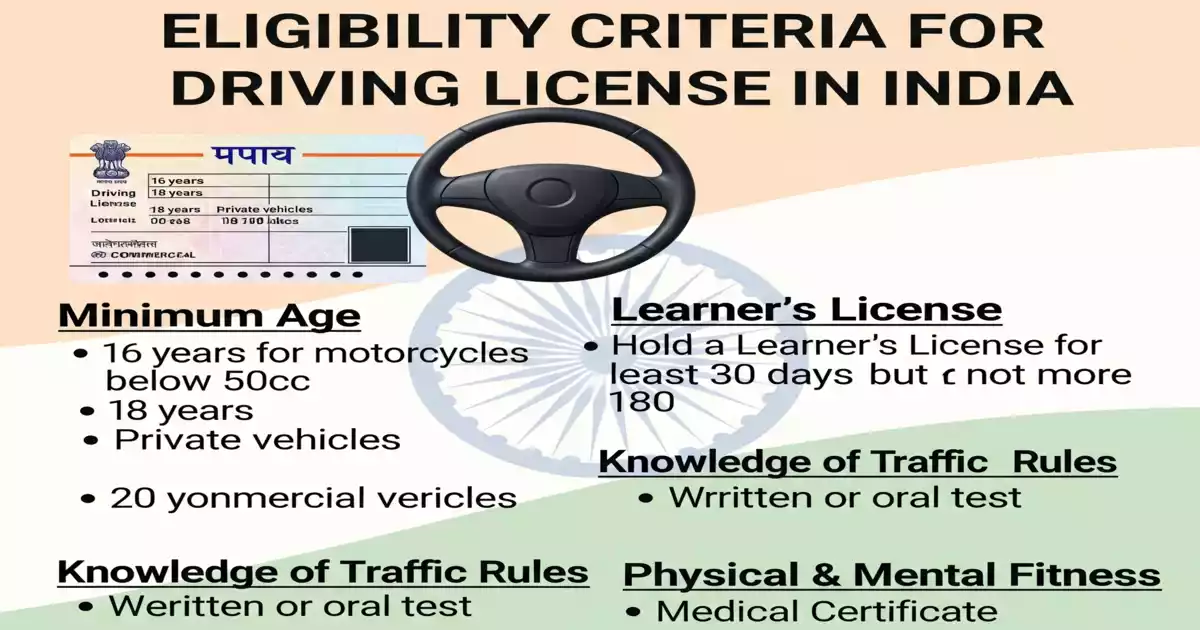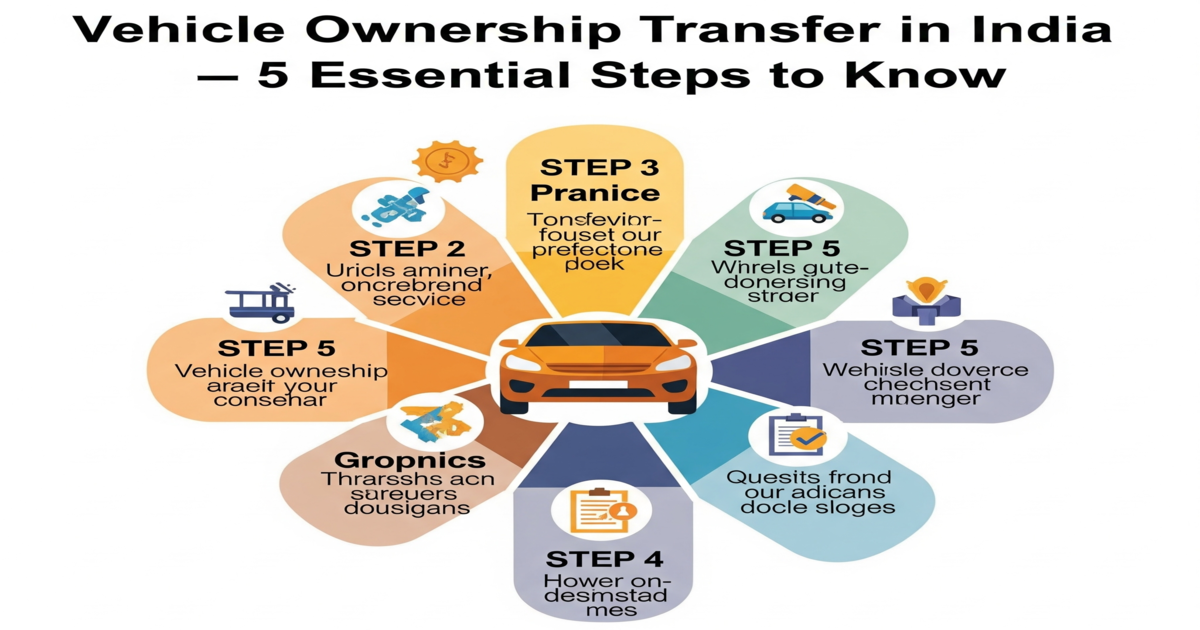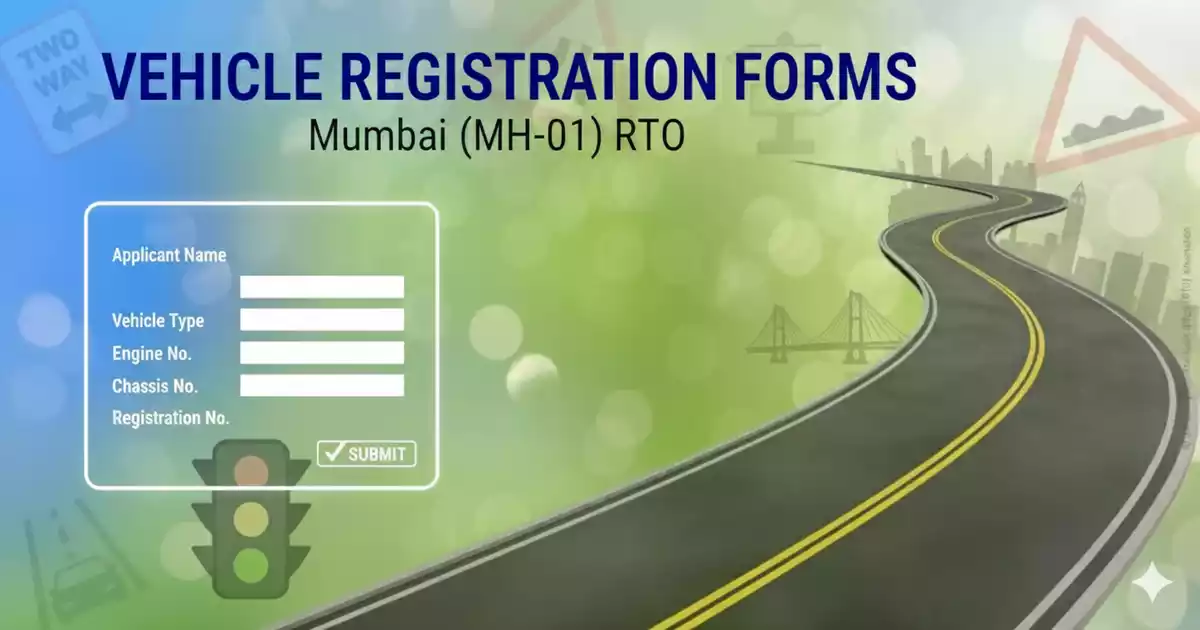Driving License Eligibility in India – Complete Guide
Getting a driving license in India is not just a formality—it’s a legal requirement under the Motor Vehicles Act, 1988. A license proves that the holder is not only aware of traffic rules but also medically and mentally fit to operate a vehicle safely. However, before applying for a learner’s or permanent license, applicants must meet specific eligibility criteria. These requirements vary depending on the type of vehicle, age group, and purpose of driving (personal or commercial).
In this guide, we’ll cover the five essential eligibility criteria for obtaining a driving license in India, breaking down everything you need to know in simple terms.
1. Minimum Age Requirements
Age is the most important factor in determining license eligibility in India. Different vehicle categories come with different age limits to ensure that only responsible drivers are allowed on the road.
- Two-Wheelers (up to 50cc): Minimum 16 years with written consent from a parent or guardian. This rule allows teenagers to start driving lightweight, gearless scooters under supervision.
- Two-Wheelers (with gear) & LMV (Light Motor Vehicles): Minimum 18 years. This includes motorcycles above 50cc, scooters, and private cars.
- Commercial Vehicles (Transport Vehicles): Minimum 20 years in most states, though some allow 18. Applicants must also have at least 1 year of LMV driving experience before applying.
👉 The age restriction exists because driving is not just about handling a vehicle—it requires maturity, awareness, and responsibility. Younger drivers are gradually introduced to smaller vehicles before advancing to heavier or commercial ones.
2. Educational Qualification Criteria
Education plays a role in safe driving, though the requirements differ depending on the license type.
- Private Vehicles: No strict academic qualifications are necessary. However, basic literacy is important to understand road signs, safety instructions, and application forms.
- Commercial Vehicles: Earlier, the law required applicants to have passed at least 8th standard. In 2018, the Ministry of Road Transport and Highways removed this rule, making it easier for people to apply. Still, basic reading and writing skills in English or the regional language are highly recommended.
👉 Even if the law doesn’t mandate formal education for private licenses, literacy gives drivers an edge in understanding rules and handling emergency situations effectively.
3. Health and Medical Fitness Requirements
Driving demands both physical and mental fitness. For this reason, the RTO has strict health requirements to ensure only medically fit individuals are allowed to drive.
- Medical Certificate: Required for applicants above 50 years and for all commercial vehicle applicants. This must be submitted using Form 1A, signed by a certified medical practitioner.
- Vision Requirements:
- Drivers must have normal or corrected vision (glasses/contact lenses allowed).
- Color blindness may disqualify an applicant if it affects traffic signal recognition.
- Night blindness is also a limiting factor.
- Physical and Mental Fitness:
- Applicants with epilepsy, severe heart conditions, or uncontrolled diabetes may be restricted.
- Mental health issues that impair awareness or judgment can also disqualify applicants.
- Physically challenged individuals can still apply if the vehicle is specially modified and approved by authorities.
👉 These rules ensure drivers are capable of making quick decisions and handling unexpected situations, reducing risks on the road.
4. Proof of Identity and Address
Documentation plays a crucial role in verifying eligibility for a driving license. Applicants must provide both identity proof and address proof at the time of application.
- Accepted Identity Proof Documents:
- Aadhaar Card
- Passport
- PAN Card
- Voter ID
- Birth Certificate
- Accepted Address Proof Documents:
- Utility bills (Electricity, Water, Gas)
- Passport
- Ration Card
- Bank Passbook with address
- Rental Agreement (with police verification in some states)
- Additional Documents for Minors:
- Parental consent form for applicants below 18 years.
- Parent’s ID and address proof.
👉 Submitting accurate and verifiable documents ensures smooth processing of the application and prevents misuse of driving licenses as identification.
5. Learner’s License and Permanent License Eligibility
Before applying for a permanent license, every applicant must first get a learner’s license. Let’s look at the conditions for different license types:
Learner’s License
- Age Criteria:
- 16 years for gearless two-wheelers (with consent).
- 18 years for geared two-wheelers and LMVs.
- 20 years for commercial vehicles.
- Validity: 6 months from the date of issue.
- Conditions: Must display an “L” sign, drive under supervision, and follow restrictions.
Permanent Driving License
- Can only be applied for after 30 days of holding a learner’s license.
- Applicants must pass a driving test, which includes both theory and practical evaluations.
Commercial Driving License
- Stricter eligibility due to safety concerns.
- Must have 1 year of LMV driving experience.
- Medical certificate is compulsory.
- Police verification may be conducted.
International Driving Permit (IDP)
- Requires a valid permanent driving license (at least 1 year old).
- Minimum age: 18 years.
- Additional documents: Passport, visa, travel tickets.
- Valid for 1 year from the date of issue.
Renewal of Driving License
- Valid for 20 years or until the holder turns 50 years old, whichever is earlier.
- After 50, renewal is required every 5 years.
- Applicants above 40 must submit a fresh medical certificate.
👉 This structured licensing system ensures that every stage—learner, permanent, commercial, and international—is designed to build responsible, experienced, and safe drivers.
Conclusion
Driving in India comes with great responsibility, and eligibility criteria for a driving license are designed to ensure safety for everyone on the road. From age and education requirements to health checks and documentation, every rule plays a role in shaping disciplined drivers. Whether you’re applying for a learner’s license, a permanent one, or even an international permit, meeting these conditions is the first step toward becoming a responsible driver.
FAQs
Q1. Can I apply for a driving license in India without Aadhaar?
Yes, Aadhaar is not mandatory. You can use other valid identity and address proofs like a Passport, Voter ID, or PAN card.
Q2. Is a medical certificate required for all driving license applications?
No, it is only mandatory for applicants above 50 years and those applying for commercial vehicle licenses.
Q3. Can I get a learner’s license online in India?
Yes, most states allow online applications through the Parivahan portal, where you can fill out forms, upload documents, and book a test slot.
Q4. What happens if I don’t renew my license on time?
You can renew it within 5 years of expiry. Beyond that, you’ll have to reapply for a new license.
Q5. Can a 17-year-old drive a car in India with parental consent?
No, the minimum age for cars and LMVs is 18 years. A 17-year-old can only drive a gearless two-wheeler (up to 50cc) with consent.



